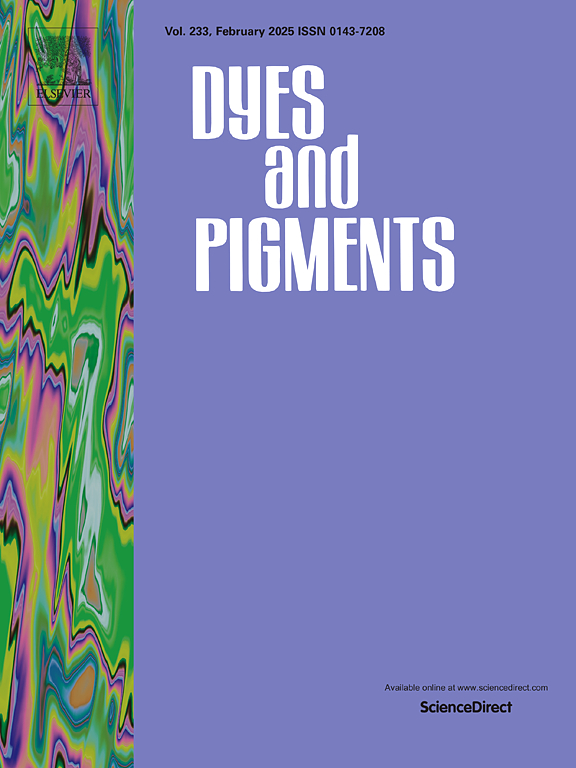Decoding the heavy atom effect and Spin–orbit coupling in D-A Molecules: Synergy or Antagonism in facilitating intersystem crossing
IF 4.1
3区 工程技术
Q2 CHEMISTRY, APPLIED
引用次数: 0
Abstract
Intersystem crossing (ISC) of triple photosensitizers (PSs) often hinges on enhanced spin−orbit coupling (SOC), typically achieved by incorporating heavy atoms or designing orthogonal donor-acceptor (D-A) dyads. Herein, we explore the synergistic potential of both strategies by integrating a heavy atom and an orthogonal D-A structure within a single PS framework. Specifically, orthogonal heptamethine cyanine (OrT-Cy7-H) is halogenated to yield OrT-Cy7-Cl and OrT-Cy7-Br via molecular engineering. Through theoretical calculations and time-resolved spectroscopy, the ISC of OrT-Cy7-Br is confirmed to be derived from the bromine substitution and the nearly orthogonal D-A structure. Interestingly, the incorporation of bromine enhances molecular aggregation and promotes non-radiative decay through intermolecular collisions. When formulated into nanoparticles, OrT-Cy7-Br exhibits efficient combined photodynamic and photothermal therapeutic effects, underscoring the critical role of both molecular structure and intermolecular interactions in shaping the photophysical properties of PSs. These findings offer valuable insights into the design of next-generation PSs for advanced cancer therapy.
解码D-A分子中的重原子效应和自旋轨道耦合:促进系统间交叉的协同或拮抗作用
三重光敏剂(ps)的系统间交叉(ISC)通常取决于增强的自旋-轨道耦合(SOC),通常通过加入重原子或设计正交给体-受体(D-A)二元体来实现。在此,我们通过在单个PS框架内整合重原子和正交D-A结构来探索这两种策略的协同潜力。具体来说,正交七甲基菁菁(OrT-Cy7-H)通过分子工程卤化得到了OrT-Cy7-Cl和OrT-Cy7-Br。通过理论计算和时间分辨光谱分析,证实了OrT-Cy7-Br的ISC来源于溴取代和近正交的D-A结构。有趣的是,溴的加入增强了分子聚集,并通过分子间碰撞促进了非辐射衰变。当制成纳米颗粒时,OrT-Cy7-Br表现出有效的光动力和光热综合治疗效果,强调了分子结构和分子间相互作用在形成ps光物理性质中的关键作用。这些发现为设计用于晚期癌症治疗的下一代ps提供了有价值的见解。
本文章由计算机程序翻译,如有差异,请以英文原文为准。
求助全文
约1分钟内获得全文
求助全文
来源期刊

Dyes and Pigments
工程技术-材料科学:纺织
CiteScore
8.20
自引率
13.30%
发文量
933
审稿时长
33 days
期刊介绍:
Dyes and Pigments covers the scientific and technical aspects of the chemistry and physics of dyes, pigments and their intermediates. Emphasis is placed on the properties of the colouring matters themselves rather than on their applications or the system in which they may be applied.
Thus the journal accepts research and review papers on the synthesis of dyes, pigments and intermediates, their physical or chemical properties, e.g. spectroscopic, surface, solution or solid state characteristics, the physical aspects of their preparation, e.g. precipitation, nucleation and growth, crystal formation, liquid crystalline characteristics, their photochemical, ecological or biological properties and the relationship between colour and chemical constitution. However, papers are considered which deal with the more fundamental aspects of colourant application and of the interactions of colourants with substrates or media.
The journal will interest a wide variety of workers in a range of disciplines whose work involves dyes, pigments and their intermediates, and provides a platform for investigators with common interests but diverse fields of activity such as cosmetics, reprographics, dye and pigment synthesis, medical research, polymers, etc.
 求助内容:
求助内容: 应助结果提醒方式:
应助结果提醒方式:


